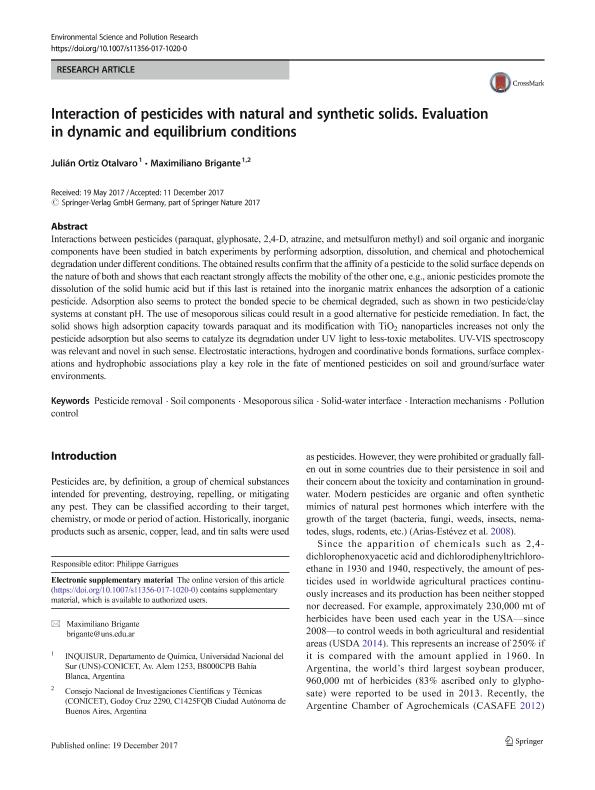Artículo
Interaction of pesticides with natural and synthetic solids. Evaluation in dynamic and equilibrium conditions
Fecha de publicación:
03/2018
Editorial:
Springer Heidelberg
Revista:
Environmental Science and Pollution Research
ISSN:
0944-1344
Idioma:
Inglés
Tipo de recurso:
Artículo publicado
Clasificación temática:
Resumen
Interactions between pesticides (paraquat, glyphosate, 2,4-D, atrazine, and metsulfuron methyl) and soil organic and inorganic components have been studied in batch experiments by performing adsorption, dissolution, and chemical and photochemical degradation under different conditions. The obtained results confirm that the affinity of a pesticide to the solid surface depends on the nature of both and shows that each reactant strongly affects the mobility of the other one, e.g., anionic pesticides promote the dissolution of the solid humic acid but if this last is retained into the inorganic matrix enhances the adsorption of a cationic pesticide. Adsorption also seems to protect the bonded specie to be chemical degraded, such as shown in two pesticide/clay systems at constant pH. The use of mesoporous silicas could result in a good alternative for pesticide remediation. In fact, the solid shows high adsorption capacity towards paraquat and its modification with TiO2 nanoparticles increases not only the pesticide adsorption but also seems to catalyze its degradation under UV light to less-toxic metabolites. UV-VIS spectroscopy was relevant and novel in such sense. Electrostatic interactions, hydrogen and coordinative bonds formations, surface complexations and hydrophobic associations play a key role in the fate of mentioned pesticides on soil and ground/surface water environments.
Archivos asociados
Licencia
Identificadores
Colecciones
Articulos(INQUISUR)
Articulos de INST.DE QUIMICA DEL SUR
Articulos de INST.DE QUIMICA DEL SUR
Citación
Ortiz Otalvaro, Julian Andres; Brigante, Maximiliano Eduardo; Interaction of pesticides with natural and synthetic solids. Evaluation in dynamic and equilibrium conditions; Springer Heidelberg; Environmental Science and Pollution Research; 25; 7; 3-2018; 6707-6719
Compartir
Altmétricas




